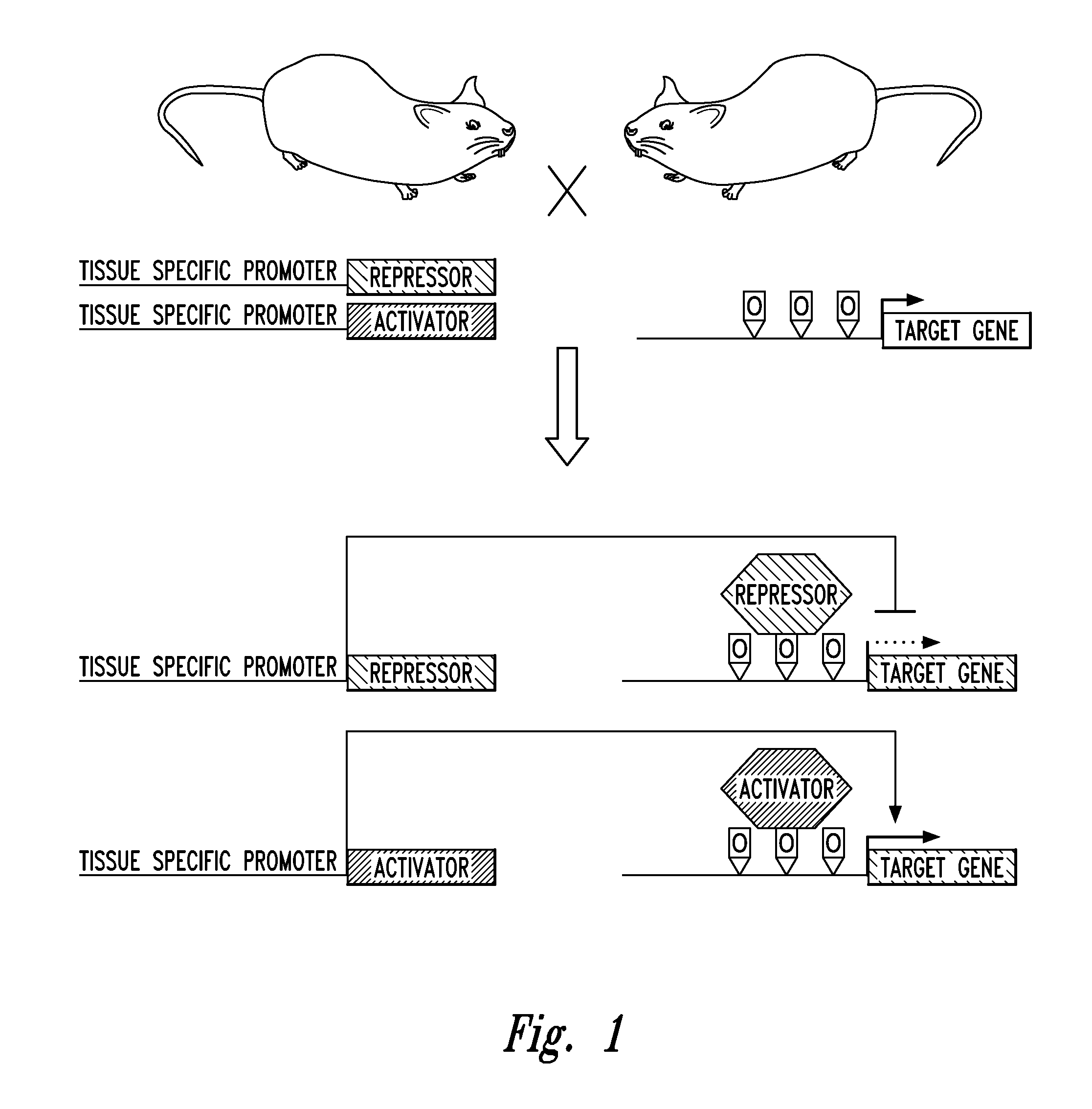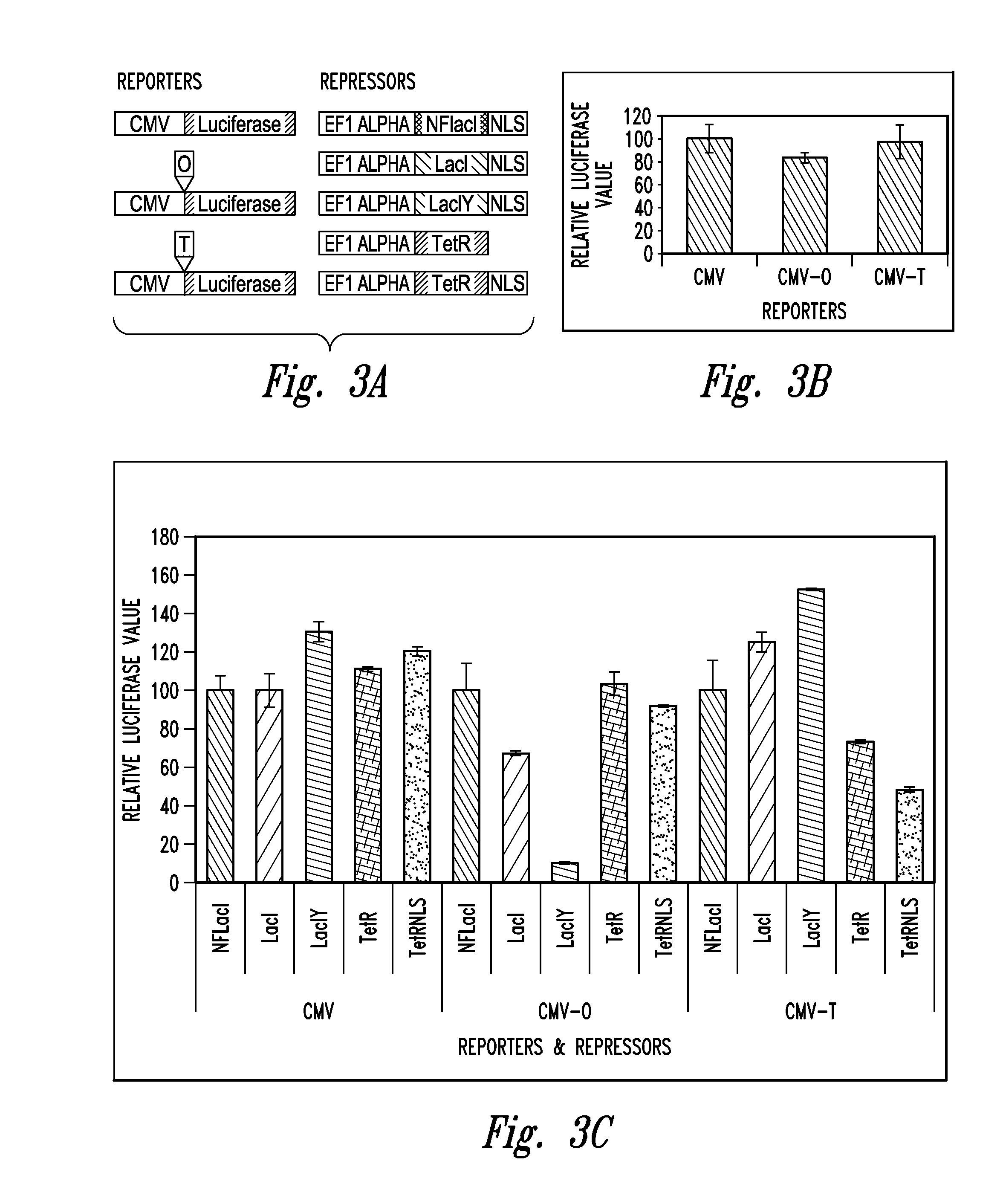Control of endogenous dnmt1 gene expression by exogenous binary regulatory systems
- Summary
- Abstract
- Description
- Claims
- Application Information
AI Technical Summary
Benefits of technology
Problems solved by technology
Method used
Image
Examples
example 1
Materials and Methods
[0073]Plasmid Construction
[0074]The pGL3O and pGL3T plasmids were generated by inserting DNA oligos containing a lac operator and a tet operator flanked by a SacI and HindIII sites (5′-3′) into the pGL3 Basic (promega) vector using the enzyme sites.
[0075]The luciferase reporter plasmid harboring the CMV promoter (pCMVL) was constructed by PCR amplifying the promoter using the forward and reverse primers harboring a NotI and AvrII site respectively. The amplicon was digested with the NotI and AvrII and ligated into the pGL3O vector digested with the NotI and SpeI.
[0076]The pCMVOL and pCMVT were generated by PCR amplifying the CMV promoter using the same primers used to generated pCMVL. The amplicon was digested with the NotI and AvrII and ligated into the pGL3O vector digested with the NotI and AvrII.
[0077]The pLacI was constructed by replacing the 5′ end (36 bp) and EcoRV-PvuII flanked 150-bp regions of the pSYNIacI (from Dr. Scrable) with the same regions from ...
example 2
Comparison Between lac and tet Control Systems
[0088]According to certain aspects, to achieve the reversible control of a target gene expression in mammalians, two art-recognized prokaryotic binary transcriptional regulatory systems, lac and tet operator / repressor, were adopted. The functionality and reversibility of both systems for transgenes have been previously demonstrated in mice (Kistner et al., 1996)(Cronin et al., 2001). The Applicants compared the two systems in a luciferase reporter assay. For repression comparisons, the Lac operator (lacO) or Tet operator (tetO) sequence was placed in between the CMV promoter and the luciferase gene. Plasmids harboring repressors are engineered identically except for the region encoding each repressor, thereby allowing the comparison of their repression capacity per gene copy, which is a relevant comparison for a transgenic approach (FIG. 3, panel A). Five different repressors were subjected to the comparison: non-functional lac repressor...
example 3
Construction of Symmetric and Consensus Sequence Operators
[0090]The consensus operator is a 29-bp sequence, which is almost a palindrome, but asymmetric by 4 mis-pairs. A 30-bp perfectly symmetric lac operator sequence (SEQ ID NO:3) has been synthesized and shown to interact with lac repressor at least 10 times more strongly than the consensus sequence (FIG. 9, panel A and (Simons et al., 1984)). Applicants used this modified lac operator to the system to improve the binding affinity between the operator and the repressor. The reporter with a symmetric operator sequence was better repressed by both lacI and lacIY than the one with a consensus operator in the given experimental condition (FIG. 9, panel B). Applicants' also doubled the number of operator sequences to improve repression. In certain embodiments, this alteration improves the binding kinetics between the operator and the repressor. Results from doubling the operator sequence show that repression was improved about 50%, wh...
PUM
| Property | Measurement | Unit |
|---|---|---|
| Gene expression profile | aaaaa | aaaaa |
Abstract
Description
Claims
Application Information
 Login to View More
Login to View More - R&D
- Intellectual Property
- Life Sciences
- Materials
- Tech Scout
- Unparalleled Data Quality
- Higher Quality Content
- 60% Fewer Hallucinations
Browse by: Latest US Patents, China's latest patents, Technical Efficacy Thesaurus, Application Domain, Technology Topic, Popular Technical Reports.
© 2025 PatSnap. All rights reserved.Legal|Privacy policy|Modern Slavery Act Transparency Statement|Sitemap|About US| Contact US: help@patsnap.com



